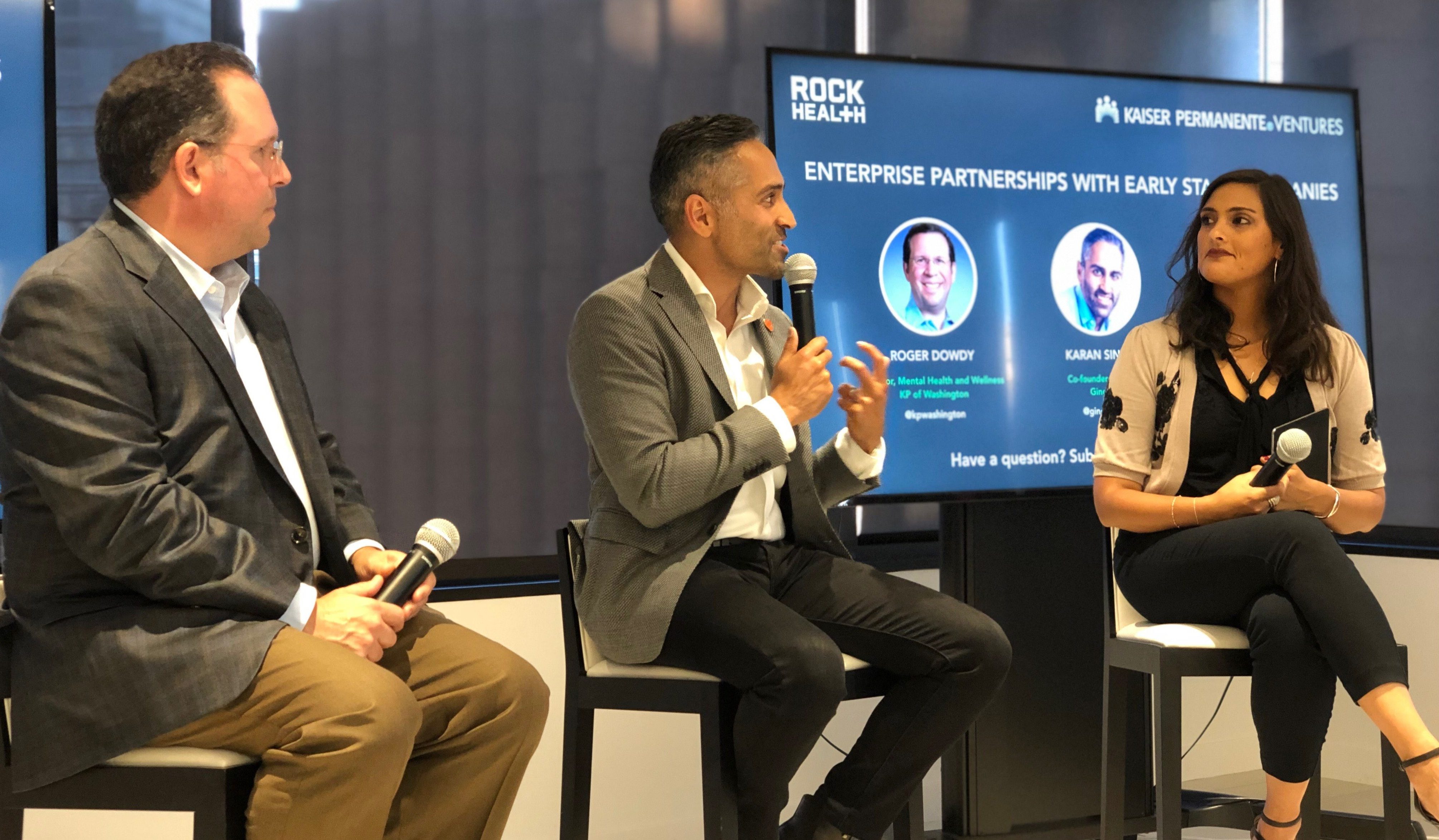What it takes to build a successful enterprise-startup partnership in digital health: Part 2
This is a recap of the second in a series of two events hosted with Kaiser Permanente Ventures on enterprise-startup partnerships. Check out key takeaways from our first event here.
By now it’s no secret most digital health companies achieve growth and scale through enterprise organizations, such as health systems, payers, and pharmaceutical companies. But in increasingly crowded spaces like digital mental health, standing out from the pack is paramount to success. That’s why we recently dug into what it takes for a digital health company to successfully build a large enterprise partnership—and how the two can start off on the right foot.
Our recent co-hosted event with Kaiser Permanente Ventures (KPV) featured leaders from Kaiser Permanente Washington (KPWA) and Ginger. Ginger, a KPV portfolio company, offers on-demand behavioral health coaching, teletherapy, telepsychiatry and guided self-care through a smartphone app to help people manage a full spectrum of mental health concerns. During the conversation moderated by Shruti Kothari, KPV’s Director of Strategic Engagement, Roger Dowdy, Director of Mental Health and Wellness at KPWA and Karan Singh, Co-founder and COO of Ginger, opened up about what brought their two companies together and how they cultivated a trusting relationship. Listen below for the full conversation on the Rock Health Podcast—and continue reading for key takeaways from the discussion.
Reframe crisis as opportunity
Demand for mental healthcare is rising nationally amidst a growing shortage of mental health professionals. According to Dowdy, KPWA receives over 7K requests per month for mental health services. With demand far exceeding provider capacity, KPWA turned its attention to external partners that could help meet all of its members’ mental health needs.
At this point, Dowdy was guided by his internal mantra: “never waste a good crisis.” He compiled a short list of potential partners, including Ginger, who would enable KPWA to meet the needs of its members through a scalable, digital-first model.

But Dowdy wasn’t looking for just any partner—he recognized the need for a company that shared his vision for reinvigorating mental healthcare with technology. And while telemedicine wasn’t leveraged widely by KPWA, both leaders viewed it as a means to ease patient access and affordability of care.
Though Ginger initially offered its services to employers, the company realized there were significant advantages to collaborating with KPWA, whose leaders understood care delivery and saw the value of using technology to scale its providers. Ginger actively sought to understand the goals of KPWA and implement solutions that met their top priorities. Meanwhile, KPWA valued Ginger’s willingness to grow with them. With a shared interest of creating “a world where mental healthcare is never an obstacle,” the two companies got to work.
Transparency and flexibility are fundamental building blocks
Ginger’s world-class technology isn’t just what caught Dowdy’s attention—Singh’s transparency during their initial conversations offered a foundation of trust. Dowdy cautioned, “Some vendors promised the moon and stars—but when we scratched beyond the surface, it turned out they didn’t have an adequate provider network to support our members.”
During the early stages of the partnership, KPWA communicated two clear goals for the partnership: leverage Ginger’s solution to connect patients to mental health services as quickly as possible and enable seamless referrals between Ginger’s teletherapy and KPWA’s Mental Health Access Center. With these expectations and clear picture of Ginger’s growing capabilities, KPWA and Ginger worked in lockstep to build an offering that would meet KPWA’s immediate needs. For instance, Ginger adapted its model to focus on delivering video visits as a first touchpoint for therapeutic support instead of rolling out its full suite of offerings.
Establish KPIs at the outset—and regularly check in on progress
Singh asserts that at the outset of any relationship, startups and enterprises must work together to identify “quantifiable target metrics so there’s less wiggle room on both ends.” By establishing clear KPIs—such as wait times for accessing care, patient satisfaction, and clinical outcomes—Ginger knew what data they needed to collect to demonstrate value to KPWA. The defined KPIs were also tied to payment structures, which created aligned incentives on both ends.
Dowdy and Singh also agreed to monthly calls to assess the operational efficiency of the relationship and check-in on progress toward KPIs. Creating strong feedback loops facilitated a healthy, iterative discussion and supported the longevity of this enterprise-startup partnership.
Rock Health is building the two-sided market for digital health
Get in touch to learn more about how your enterprise organization can access cutting-edge healthcare innovation by becoming a Rock Health corporate partner. And join us as an Insider at the eighth annual Rock Health Summit on September 24-25 to hear more from experts on the scalable adoption of digital health technologies.
Working on a solution to drastically improve healthcare? We’d love to hear from you—tell us about your company.
Stay up to date with the most important news in digital health. Sign up for the Rock Weekly below.

